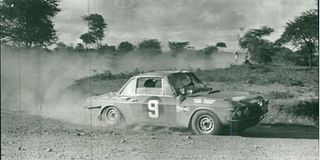Easter evokes memories of the Safari Rally of old

Rauno Aaltonen the Flying Finn, with co-driver Henry Liddon of Britain tame a hair-pin bend at speed in their Lancia, which finished the Safari Rally in ninth place overall in this undated file photo.
What you need to know:
- The Safari became a professional body as Jack Howell was appointed as the rally’s Executive Manager, a management structure exists to this day as Phineas Kimathi serves as the Chief Executive Officer of the event.
Very little else will be happening in Kenya this Easter weekend apart from the ordinary.
Moneyed Kenyans will make merry, farmers will continue planting, hustlers will continue wallowing in economic misery, and with the simmering political temperatures now cooling down, politicians will troupe to places of worship, which is good for the country.
But fans of motorsport will remember that the World Rally Championship Safari Rally defined the Easter holiday celebrations in Kenya for 46 years when everything else mattered less.
Each edition of the Safari Rally had its unique DNA from the first edition in 1953 but no other Safari Rally had as a great impact as the 1963 event at home and abroad in history.
The year 1963 was quite unique. The Safari was held this weekend 60 years ago (April 11-15). Only seven out of 107 drivers finished the Safari or the "Unsinkable Seven".
East Africa had never been blessed with too much rain like that month of April. A new slogan which would out-last the best marketing campaigns for a generation was coined.
Two men, S. Mwangi and K. Karare in a Fiat 1500 represented the hope of a whole nation.
Kenya was only 45 days away from being declared a self-governed country and many able-bodied hustlers of the day had free “lunch” along the Safari Rally route for pulling out cars bogged down in the mud after heavy rains for tidy sums of money unperturbed by the “Bwana” master/servant inferior attitude of the White colonialists for the first time in history.
The 1963 Safari Rally would have fitted well in the 2023 FIA World Championship Safari Rally.
Over 100 TV journalists, with celebrities in tow, jetted into Kenya not to cover the historic first self-rule Madaraka Day celebrations but the Safari.
Their presence somehow put Kenya on the world map in readiness for the Madaraka Day celebrations, a jump-starter for international media attention on a country which went on to emerge as the gateway to Eastern Africa region, the leader in the industry, communication, commerce and sports.
Starting only 10 years earlier, the Safari came off age as a unique and tough event. For the first time factory teams decided to make a try. Datsun and Hino became the first Japanese manufacturers to field full works teams, Rover brought in Rover P5. East Africans showed up in Peugeots and three brands of Ford_ Anglia, Cortina and the Zodiac.
The legendary Rauno Aaltonen came from Finland for his second Safari attempt in a Mini Works car. He would return for 21 years chasing the elusive first Safari title in vain.
Such was Aaltonen’s pulling power that he became a celebrity amongst Kenyans who believed that their hero may have been “cursed” with a bad omen by a medicine man for running over his magical powers gourd somewhere in Ukambani.
Saab entered Erik Carlsson from Sweden who led most of the way before Kenyans and their local knowledge prevailed.
The rains were so heavy that maximum lateness was extended twice for a total of 16 hours. Bridges or wash ways were either swept or submerged.
Some sections were littered with cars facing different directions offering hustlers of the day their first opportunity to exploit the desperate drivers to the maximum by asking obscene amounts of money without fear of retribution from the feared White colonialists. Indeed independence was coming.
The action was relayed live on Voice of Kenya radio across East Africa and updates after every four hours, newspapers dispatched field reporters and photographers in an era of analogue and set aside acres of pages.
Nick Nowicki in a Peugeot 404 arrived in Nairobi over 90 minutes ahead of Peter Hughes and Beau Younghusband after Carlsson’s demise in Mbulu. Hughes in a Ford Anglia soon moved to second after Younghusband retired followed by Bill Cardwell in a Mercedes Benz 220 SEB.
There was only one rally in the world which could be compared to Safari_ Liege-Sofia-Liege. In the end, it was relegated to second place by the Safari because of the high retirement rate.
Only seven drivers finished the Safari, earning them the nickname the “Magnificent Seven”, the Safari rightfully became known as the “toughest Rally in the World”, and a brand name subject that was once cited to the undergraduates at the University of Nairobi Business School as a slogan has infinite brand equity potential when well used.
The Safari became a professional body as Jack Howell was appointed as the rally’s Executive Manager, a management structure exists to this day as Phineas Kimathi serves as the Chief Executive Officer of the event.
Tomorrow: A decade later, the Safari becomes a round of the FIA World Rally Championship, the beginning, rising and rising of Shekhar Mehta




